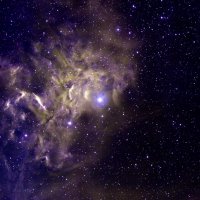Technorati Tags: ASTRONOMICAL or GALAXY and Big Bang or stellar evolution and Astrophysics or supernova and black+hole or astronomers and neutron star or Far Ultraviolet Spectroscopic Explorer and Milky Way galaxy or universe and deuterium or hydrogen isotope
 | Caption: A false-color image of the star AE Aurigae, embedded in a region of space containing smoke-like filaments of carbon-rich dust grains, a common phenomenon. |
Because deuterium is a tracer of star and galaxy evolution, this discovery could radically alter theories about how stars and galaxy form. Credit: Credit: T.A. Rector and B.A. Wolpa, NOAO, AURA, and NSF, Usage Restrictions: None.
Surprising telescope observations shake up galactic formation theories
A heavy form of hydrogen created just moments after the Big Bang has been found to exist in larger quantities than expected in the Milky Way, a finding that could radically alter theories about star and galaxy formation, says a new international study led by the University of Colorado at Boulder.
CU-Boulder astrophysicist Jeffrey Linsky said new data gathered by NASA's Far Ultraviolet Spectroscopic Explorer, or FUSE, satellite, shows why deuterium appears to be distributed unevenly in the Milky Way Galaxy. It apparently has been binding to interstellar dust grains, changing from an easily detectable gaseous form to an unobservable solid form, said Linsky, a fellow of JILA, a joint institute of CU-Boulder and the National Institute of Standards and Technology.
The FUSE deuterium study, six years in the making, solves a 35-year-old mystery concerning the distribution of deuterium in the Milky Way while posing new questions about how stars and galaxies are made, according to the research team. A paper on the subject by a team of international researchers led by Linsky is being published in the Aug. 20 issue of The Astrophysical Journal.
"Since the 1970s, we have been unable to explain why deuterium levels vary all over the place," said Linsky. "The answer we found is as unsettling as it is exciting."
Since deuterium -- a hydrogen isotope containing a proton and a neutron -- is believed burned and lost forever during star formation, scientists think the amount of deuterium present in the universe is "pure" and serves as a tracer for star creation and galaxy building over billions of years, said Linsky. While primordial deuterium in the distant, early universe has been measured at concentrations of about 27 parts per million parts hydrogen atoms, measurements by FUSE and NASA's Copernicus satellite have shown a "patchy" distribution of the element in the Milky Way galaxy, often at far lower levels.
In 2003, Princeton University's Bruce Draine, a co-author on the new study, developed a model showing that deuterium, when compared to hydrogen, might preferentially bind to interstellar dust grains. The observations by FUSE -- which can detect the telltale spectral fingerprints of deuterium in the ultraviolet energy range -- strongly support the theory, according to The Astrophysical Journal paper authors.
"Where there are high concentrations of interstellar dust in the galaxy, we see lower concentrations of deuterium gas with FUSE," said Linsky. "And where there is less interstellar dust, we are measuring higher levels of deuterium gas."
In relatively undisturbed areas of the universe -- like regions around Earth's sun, for example -- deuterium atoms systematically "leave" the gas phase and replace normal hydrogen atoms in dust grains, said Linsky. When a pocket of the universe is disturbed by events like a supernova shock wave or violent activity triggered by nearby hot stars, the dust grains are vaporized, releasing deuterium atoms back into a gas, which has been measured by FUSE, the researchers said.
Scientists assumed from astrophysical theories that at least one-third of the primordial deuterium present in the Milky Way was destroyed over time as it cycled through the stars, said Linsky. But according to the new FUSE findings, the present-day deuterium abundance is less than 15 percent below the primordial values.
"This implies that either significantly less material has been converted to helium and heavier elements in stars or that much more primordial gas has rained down onto the galaxy over its lifetime than had been thought," said Linsky. "In either case, our models of the chemical evolution of the Milky Way will have to be revised significantly to explain this important new result."
Launched in 1999, FUSE is a NASA Explorer mission developed in cooperation with the French and Canadian Space Agencies and by Johns Hopkins University, CU-Boulder and the University of California, Berkeley. CU-Boulder's Center for Astrophysics and Space Astronomy designed and built the mission's $9 million spectrograph, which collects and funnels UV light from the satellite's four telescopes. ###
The paper was co-authored by scientists from Princeton, Johns Hopkins and Northwestern universities, the Space Telescope Science Institute, CU-Boulder, the University of Wisconsin-Madison, the University of Texas-Austin, NASA-Goddard, the Laboratoire d'Astrophysique in Marseille, France, and the Observatoire de Paris-Meudon in Meudon, France. Other CU-Boulder co-authors include JILA's Brian Wood, CASA's Michael Shull and CASA doctoral graduate Seth Redfield.
For more information on the FUSE satellite and the spacecraft's search for deuterium go to fuse.pha.jhu.edu/ and fuse.pha.jhu.edu/wpb/.
Contact: Jeffrey Linsky jlinsky@jila.colorado.edu 720-939-7838 University of Colorado at Boulder
RELATED: Keyword, Supernova, Sunday, July 09, 2006 Supernova leaves behind mysterious object, Sunday, June 11, 2006 Massive-star supernovae found to be major space dust factories, Sunday, April 23, 2006 DEADLY ASTRONOMICAL EVENT NOT LIKELY TO HAPPEN IN OUR GALAXY,











No comments:
Post a Comment